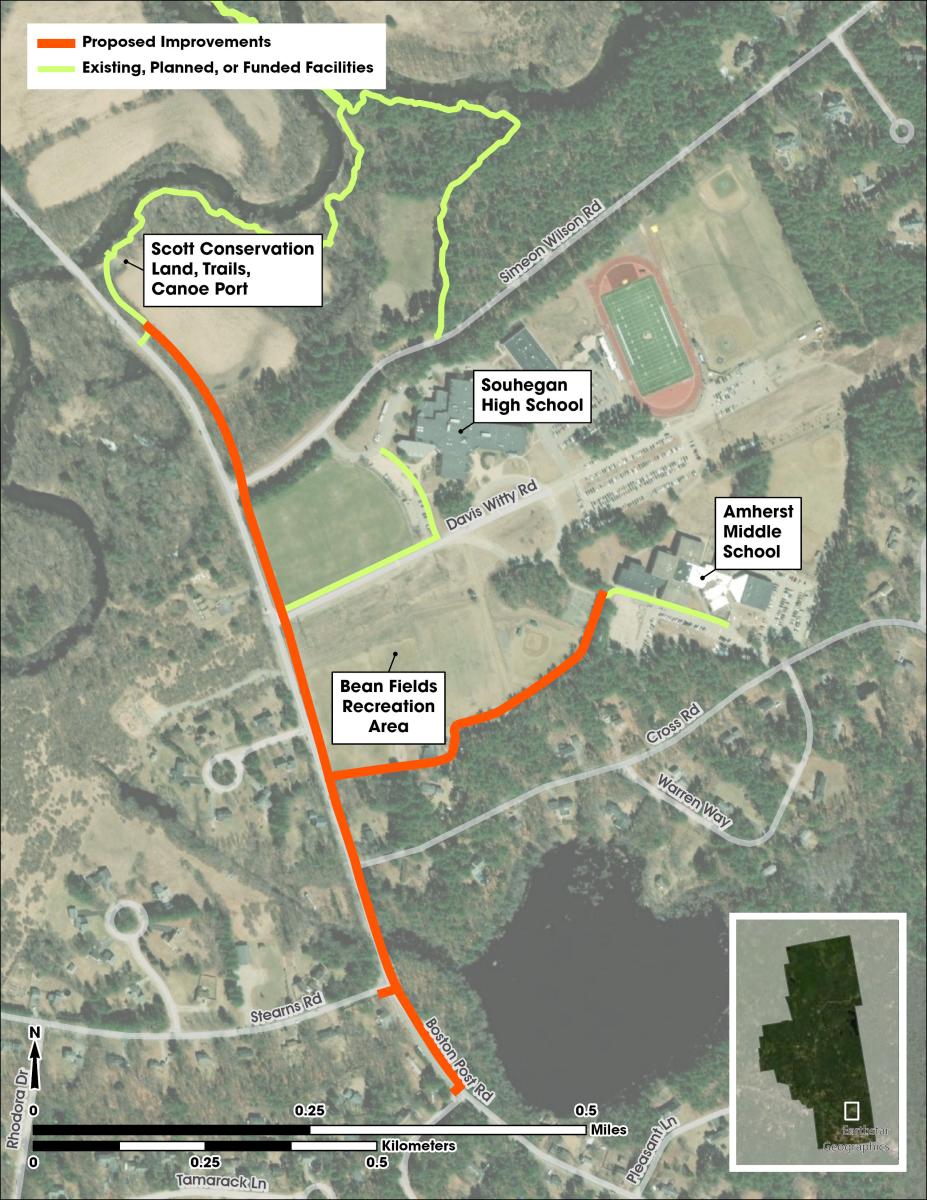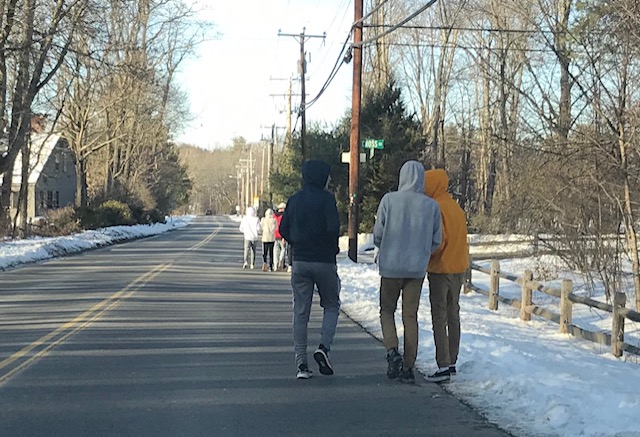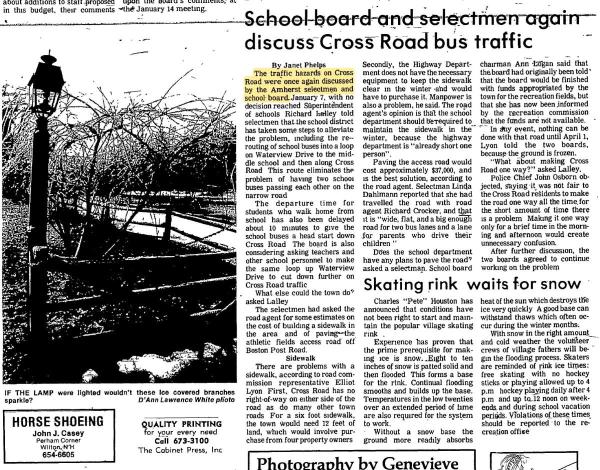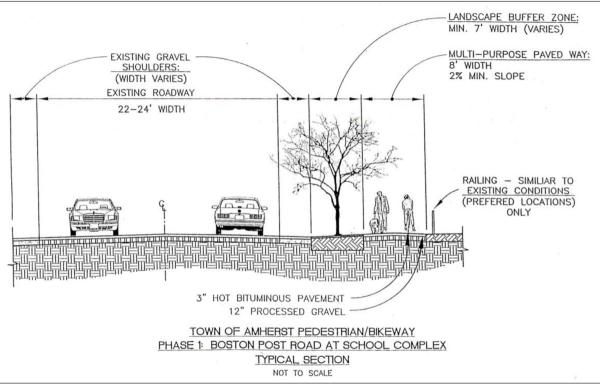AMS/SHS School Campus Project
| Organizational note |
|---|
| This initiative is a portion of the Amherst South-04 segment of the Baboosic Greenway regional project. |
The AMS/SHS School Campus Project, a vital part of the Baboosic Greenway Amherst South-04, has been a community for nearly half a century. This project is designed to establish a safe, dedicated shared-use path along Boston Post Road, directly connecting Souhegan High School and Amherst Middle School. Given its crucial role in enhancing pedestrian and cyclist safety near key educational facilities and recreational fields, this project has been actively shaped and reshaped to align with evolving funding opportunities and safety needs.
Strategically situated along Boston Post Road, this project stretches approximately 5,100 linear feet from the northern bank of the Souhegan River to Homestead Road. The road is a major artery for the town and serves a high volume of pedestrian and vehicular traffic, which includes students, residents, and visitors accessing the schools and nearby recreational facilities such as Bean Fields. The current lack of adequate pedestrian infrastructure along this busy corridor makes this project not only beneficial but necessary for community safety.
The Project
For decades, the most frequently-requested pedestrian infrastructure improvement in the Town of Amherst has been to improve safety and access along Boston Post Road, especially around Souhegan High School and Amherst Middle School.
This portion of Boston Post Road is one of the most consistently utilized by pedestrians (and other modes), as it is the only public way to access Souhegan High School and the primary means of accessing Amherst Middle School. Furthermore, adjacent recreational facilities, such as Bean Fields, are frequently used throughout the year with a usership of approximately 30,000 participants per year.
The proposed solution to this is Baboosic Greenway Amherst South-04, infrastructure that would provide a facility for pedestrians, bicyclists, and other modes that is entirely separate from the roadway. Such a project would provide a year-round, dedicated space for students and others to access the area safely and without contending with traffic on one of Amherst's highest-volume roads.
Location
This projected would build approximately 5,100 linear feet of infrastructure in the South of Amherst, mostly along Boston Post Road. This would span from the northern bank of the Souhegan River to an existing mid-block crossing at Homestead Rd in the South.

Proposed route AMS/SHS School Campus Project
Existing pedestrian infrastructure is limited to sidewalks on school grounds and local trails, but no facilities exist to provide access to and from the schools. Without adequate pedestrian infrastructure, students have, for decades, resorted to walking along Boston Post Rd to access the area.

Students walking along Boston Post Road in January 2019
A Long-Established Priority
The AMS/SHS School Campus Project began in 1974, becoming a focal point for Amherst's community safety and infrastructure planning. It responded to urgent needs for pedestrian safety around Amherst’s educational institutions, evolving significantly over the decades due to ongoing community concerns and changing infrastructure requirements.
Early Advocacy and Planning Efforts
The project’s early efforts kicked off with the establishment of Amherst Middle School, highlighting the critical need for safe pedestrian access along Cross Rd. However, these initiatives quickly encountered obstacles due to narrow right-of-way that would have required extensive property modifications or road adjustments, proving overly complex and unfeasible. By the mid-1980s, without viable alternatives or sufficient funding, the focus on Cross Rd as the sole solution led to stagnation. The project's adaptability was limited by financial constraints and a lack of broader infrastructural vision, causing efforts to falter and community needs to remain unmet.

Milford Cabinet And Wilton Journal, Page 14, from January 10, 1985 discussing the ongoing need to provide sidewalk access to the area.
Revival in the 1990s and Early 2000s
The 1990s saw a resurgence of interest, driven by the opening of Souhegan High School and increased traffic and pedestrian safety concerns along Boston Post Road. The location of Souhegan High School along Boston Post Road offered a fresh idea for routing the project. In 2001, this renewed concern led to the Town of Amherst commissioning a comprehensive plan by CLD Engineering, which proposed a, 8-foot-wide multimodal pathway along Boston Post Rd that would safely connect schools with the surrounding community. Despite the ambitious vision set by the CLD report, the project again stalled due to the absence of a dedicated group responsible for driving the long-term execution and coordinate the complex array of required tasks such as budgeting, funding, etc.

A cross section from the 2001 CLD Engineering proposal for a multimodal pathway along Boston Post Rd
Current Efforts to Finally Realize the AMS/SHS School Campus Project
A group of tireless advocates for this project formed the Safe Routes to School Committee, releasing a report in 2013, which re-emphasized the necessity for safe pedestrian routes, particularly around school zones. Ultimately, this led to the formation of the Amherst Bicycle & Pedestrian Advisory Committee (BPAC) in 2017, which took on the mantle of planning and executing the project. BPAC's active engagement in community planning and advocacy helped to align the town’s broader planning goals with actionable steps toward realizing the pathway. Their efforts were bolstered by the town raising $225,000 through warrant articles over three separate years, providing necessary local match funding to attract additional state and federal grants.
The Need for Improved Safety
Boston Post Road is designed solely to accommodate motor vehicles. No design elements have been incorporated into Boston Post Road’s engineering to provide dedicated facilities or safety improvements for pedestrians or other road users.
Furthermore, speeds along Boston Post Road regularly exceed the energy threshold to sustain serious injury or fatality in the event of a collision with a pedestrian. This unfortunate reality means that as long as pedestrian (or other) use of the roadway is required to share the same space as motor vehicles, there will exist the potential for fatal accidents in the event of a collision.
Today, the only factor preventing injurious or fatal collisions from occurring is the attentiveness and skill of every driver at all times–a dubious requirement in order to prevent death. Sadly, driver inattention has already led to fatality, as it did less than 1 mile away in 2013.
The problem of sharing space between pedestrians and motor vehicles is made worse every year when the academic calendar overlaps with persistent snow cover. When snow banks exist alongside the road, students no longer have the roadway’s shoulder as a de facto pedestrian facility. The result: groups of students are forced to walk well into the roadway, causing regular conflicts with motor vehicles attempting to use the same space, and with little room to escape a collision even with ample warning.
Project Status
| Date | Update |
|---|---|
| 2024-04 | The town applied to Senator Shaheen's office for FY 2025 Congressionally Designated Spending, but was not selected |
| 2024-03 | Amherst voters approved raising $75,000 to the Multimodal Facilities Capital Reserve Fund for this project, raising in full the required local matching funds to construct the project. |
| 2023-04 | The town applied to Senator Shaheen's office for FY 2024 Congressionally Designated Spending, the project was not selected for funding |
| 2023-03 | Amherst voters approved raising $75,000 to the Multimodal Facilities Capital Reserve Fund for this project |
| 2022-06 | This project was added to the Nashua regional Metropolitain Transportation Plan under Baboosic Greenway South-04 plan |
| 2022-04 | The town applied to Senator Shaheen's office for FY 2023 Congressionally Designated Spending, the project was not selected for funding |
| 2021-11 | Hoyle & Tanner report published clearing the final engineering hurdle for the project, determining that the water crossing at Honey Pot Brook is feasible |
| 2021-04 | The town applied for 80% funding for this project in the Transportation Alternatatives Program (TAP), but was not selected |
| 2021-03 | Amherst voters approved raising $75,000 to the Multimodal Facilities Capital Reserve Fund for this project |
| 2020-10 | Presentation to the Board of Selectmen to propose raising $225,000 over three years for this project |
2013-05 | Safe Routes to School Committee and the Nashua Regional Planning Commission published report calling for a path along Boston Post Rd |
| 2006 | Improvements in the area called for in the Transportation and Community and Systems Preservation Study for Amherst, New Hampshire report by NRPC |
2001 | Amherst commissioned CLD Engineering to develop conceptual plans for a multimodal pathway that would connect the AMS/SHS School Campus with the Amherst Village |
| 1992 | Souhegan High School opened, adding more students and greater need to provide facilities in the area. |
1984 | Board of Selectmen, School Board, and the Department of Public Works conducted a multi-year effort to construct sidewalks down Cross Rd and Boston Post Road. |
| 1977 | Boston Post Road's bridge over the Souhegan River was rebuilt with a sidewalk and the intent to build proposed sidewalk to connect Amherst Middle School with the Amherst Village |
| 1974 | Amherst Middle School opened, the first school to be built in the southern part of town. Concerns over “pedestrian traffic hazards” quickly developed |






